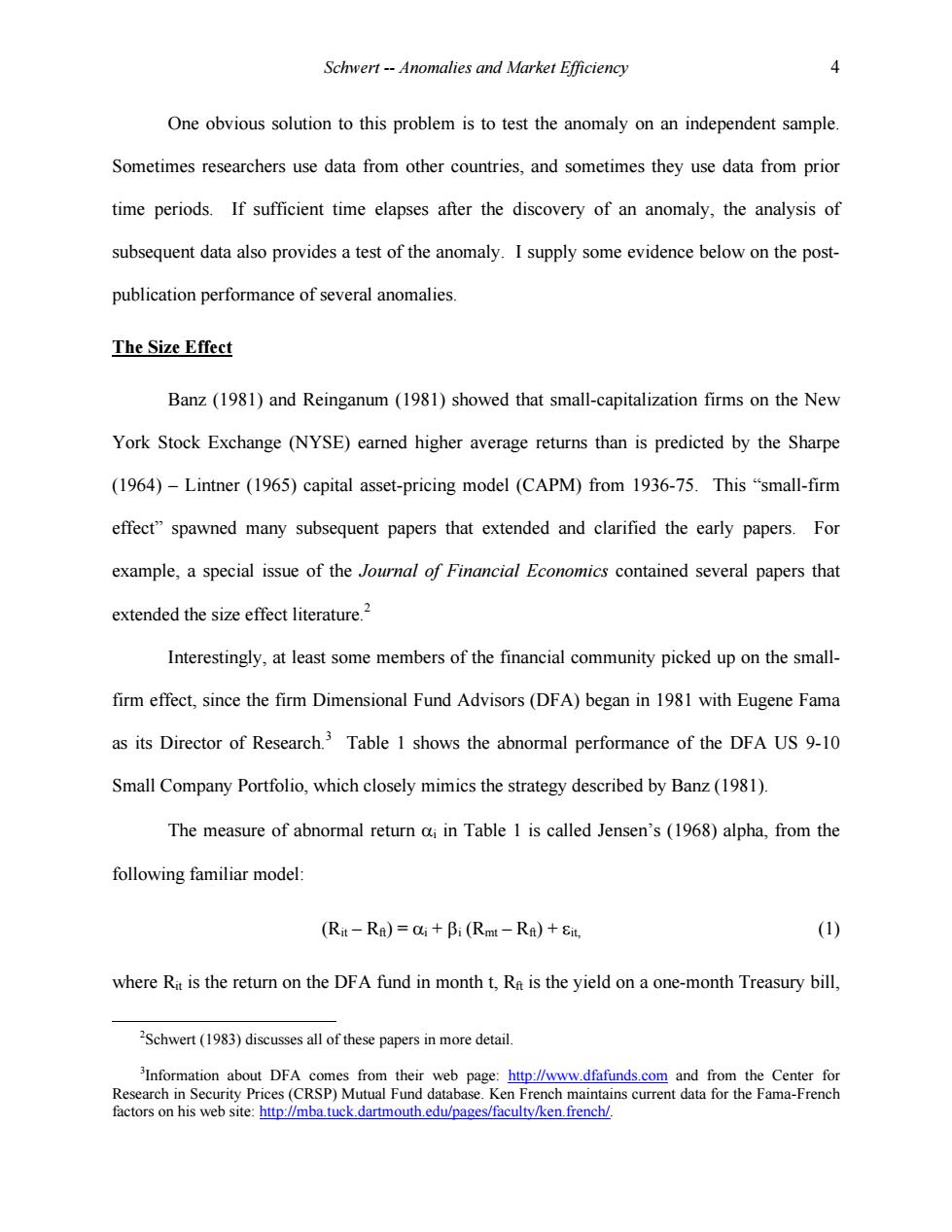正在加载图片...

Schwert--Anomalies and Market Efficiency 4 One obvious solution to this problem is to test the anomaly on an independent sample. Sometimes researchers use data from other countries,and sometimes they use data from prior time periods.If sufficient time elapses after the discovery of an anomaly,the analysis of subsequent data also provides a test of the anomaly.I supply some evidence below on the post- publication performance of several anomalies. The Size Effect Banz (1981)and Reinganum (1981)showed that small-capitalization firms on the New York Stock Exchange (NYSE)earned higher average returns than is predicted by the Sharpe (1964)-Lintner (1965)capital asset-pricing model (CAPM)from 1936-75.This "small-firm effect"spawned many subsequent papers that extended and clarified the early papers.For example,a special issue of the Journal of Financial Economics contained several papers that extended the size effect literature.2 Interestingly,at least some members of the financial community picked up on the small- firm effect,since the firm Dimensional Fund Advisors(DFA)began in 1981 with Eugene Fama as its Director of Research.'Table 1 shows the abnormal performance of the DFA US 9-10 Small Company Portfolio,which closely mimics the strategy described by Banz(1981). The measure of abnormal return ai in Table 1 is called Jensen's (1968)alpha,from the following familiar model: (Rit-Ra)=ai+Bi(Rmt-RA)+&it. (1) where Rit is the return on the DFA fund in month t,Ra is the yield on a one-month Treasury bill, 2Schwert(1983)discusses all of these papers in more detail 3Information about DFA comes from their web page:http://www.dfafunds.com and from the Center for Research in Security Prices(CRSP)Mutual Fund database.Ken French maintains current data for the Fama-French factors on his web site:http://mba.tuck.dartmouth.edu/pages/faculty/ken.french/.Schwert -- Anomalies and Market Efficiency 4 One obvious solution to this problem is to test the anomaly on an independent sample. Sometimes researchers use data from other countries, and sometimes they use data from prior time periods. If sufficient time elapses after the discovery of an anomaly, the analysis of subsequent data also provides a test of the anomaly. I supply some evidence below on the postpublication performance of several anomalies. The Size Effect Banz (1981) and Reinganum (1981) showed that small-capitalization firms on the New York Stock Exchange (NYSE) earned higher average returns than is predicted by the Sharpe (1964) – Lintner (1965) capital asset-pricing model (CAPM) from 1936-75. This “small-firm effect” spawned many subsequent papers that extended and clarified the early papers. For example, a special issue of the Journal of Financial Economics contained several papers that extended the size effect literature.2 Interestingly, at least some members of the financial community picked up on the smallfirm effect, since the firm Dimensional Fund Advisors (DFA) began in 1981 with Eugene Fama as its Director of Research.3 Table 1 shows the abnormal performance of the DFA US 9-10 Small Company Portfolio, which closely mimics the strategy described by Banz (1981). The measure of abnormal return ai in Table 1 is called Jensen’s (1968) alpha, from the following familiar model: (Rit – Rft) = ai + bi (Rmt – Rft) + eit, (1) where Rit is the return on the DFA fund in month t, Rft is the yield on a one-month Treasury bill, 2 Schwert (1983) discusses all of these papers in more detail. 3 Information about DFA comes from their web page: http://www.dfafunds.com and from the Center for Research in Security Prices (CRSP) Mutual Fund database. Ken French maintains current data for the Fama-French factors on his web site: http://mba.tuck.dartmouth.edu/pages/faculty/ken.french/